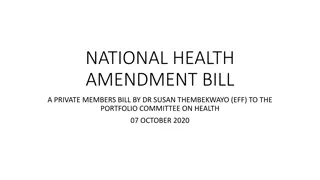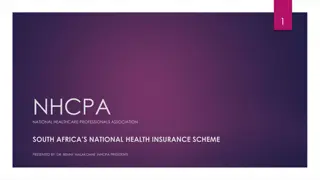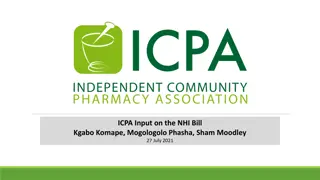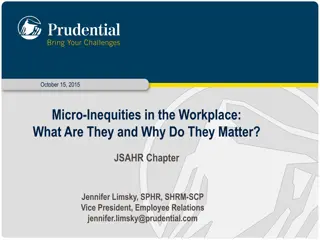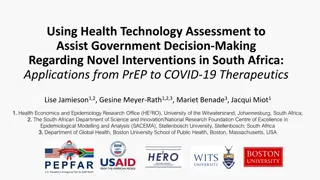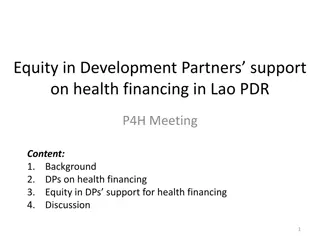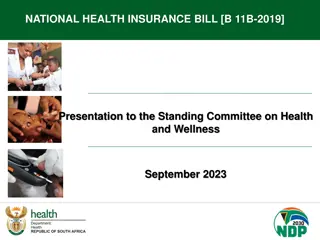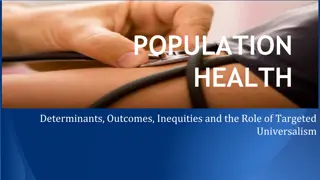National Health Insurance Bill: Addressing Inequities in South Africa's Healthcare System
South Africa's National Department of Health is responding to public hearings on the National Health Insurance Bill, emphasizing the need for collective investment in healthcare as a public good. Highlighting the country's extreme social inequality, the department argues that the current dual health system perpetuates inequities. By proposing changes to the bill and focusing on health service delivery challenges, the aim is to create a more accessible and fair healthcare system for all citizens.
Download Presentation

Please find below an Image/Link to download the presentation.
The content on the website is provided AS IS for your information and personal use only. It may not be sold, licensed, or shared on other websites without obtaining consent from the author.If you encounter any issues during the download, it is possible that the publisher has removed the file from their server.
You are allowed to download the files provided on this website for personal or commercial use, subject to the condition that they are used lawfully. All files are the property of their respective owners.
The content on the website is provided AS IS for your information and personal use only. It may not be sold, licensed, or shared on other websites without obtaining consent from the author.
E N D
Presentation Transcript
National Department of Health responses to the Portfolio Committee Public Hearings on the National Health Insurance Bill [B 11-2019] 29 March 2022
National Health Insurance Bill PURPOSE o To respond to the comments made during public hearings and oral submissions to the National Assembly Portfolio Committee on Health on the National Health Insurance Bill OVERVIEW o Why does South Africa need National Health Insurance? o Recommendations on changes to the Bill based on submissions and hearings o Tackling heath service delivery challenges 2
Why does South Africa need National Health Insurance? Health is not a tradeable commodity; it is a public good o Public goods are common resources that need to be supported by collective investment o Public goods are supported by all and accessible to all o The reason they are public goods, rather than individual commodities, is we have decided that they are so fundamental to our wellbeing that they should not be entirely the province of private investment or market forces South Africa is the most unequal society in the world o economy does not equally benefit all its citizens o 10 percent of the population owns more than 80 percent of the wealth o major examples of social inequality include income gap, gender inequality, health care, and social class o in health care, some individuals receive better and more professional care compared to others o South Africa wealth gap has been unchanged since apartheid 3
Our health care reflects our inequitable society o As a nation we spend 8,4% of our GDP on our health system but our outcome indicators are poor Roughly half of our spend is in the public sector on the majority of the population The other half is spent in the private sector on a minority of the population o Two thirds (2 of every 3) medical specialists works in the private sector We have created a dual health system that entrenches and exacerbates inequity and poor health services in both public and private sectors o Public underserviced o Private overserviced o Both duplicative and wasteful The attempts to reform health care to a national health system is not new and has been raised from time to time since 1948, as outlined in the White Paper 4
Our health system is failing everyone: o Many poor people are denied care when they need it o Many privileged people are given treatment that they don t need, some potentially harmful o Even wealthy people who insure their health with medical schemes end up paying in for costs not covered South Africa needs a health system that ensures that all people have access to the health services they need, when and where they need them, without financial hardship o This is what universal health coverage means o National Health Insurance means that we pay for this public good in advance with no cost to us as patients at the point of care when we need health services 5
Historical Context of NHI Reforms South Africa has endeavoured to implement transformation of the health system including health financing reforms over the past 94 years through: 1928 - Commission of Old Age Pension and NHI; 1941 - Collie s Committee of Inquiry into NHI; 1943 - African Claims that proposed equal treatment in the scheme of Social Security; 1943 -1944 - Dr Henry Gluckman National Health Services Commission proposal for NHI; 1955 - Freedom Charter as adopted by the Congress of the People ; 1994 - Ministerial Committee on Health Care Financing; 1995 - Ministerial Committee of Inquiry into NHI (Broomberg and Shisana Report); 1997 - Social Health Insurance Working Group; 2002 - Committee of Inquiry into a Comprehensive Social Security System (the Taylor Committee); 2002 - Ministerial Task Team on Social Health Insurance; and 2009-2014 - Ministerial Advisory Committee on NHI. The historical efforts eventually found expression in Sections 27 of the Bill of Rights of the Constitution, 1996which articulates the constitutional obligation on the State to ensure that everyone has access to health care services 6
Concerns raised by Stakeholders of the NHI as described in the Bill Issues are addressed in Department s comments with special emphasis on: Role of Provinces Service Delivery challenges: Quality and ability to achieve Accreditation Funding and Affordability Role of Medical Schemes (HMI) Fraud and Corruption Human Resources for Health 7
Concerns raised by Stakeholders of the NHI as described in the Bill Role of the Provincial Departments of Health Stakeholders raised a concern that there was a lack of detail in the Bill about the role of the Provincial Departments of Health The Bill outlines the roles of the Minister, National Department of Health, the NHIF and its substructures The roles of Provinces are outlined in the consequential amendments to the National Health Act 2003 contained in the Schedules on Repeal and amendment of Legislation affected by the Bill/ Act Section 31 (2) requires The Minister must clearly delineate in appropriate legislation the respective roles and responsibilities of the Fund and the national and provincial Departments, taking into consideration the Constitution, this Act and the National Health Act, in order to prevent duplication of services and the wasting of resources and to ensure the equitable provision and financing of health services. The functions assigned in the National Health Act can be reassigned to provide for funding shifts (the rule is funds follow functions), and the functions delegated back to enable the reforms that the NHI intends Provincial health departments remain important to the oversight and stewardship of the whole health system (not only the public sector) 8
Criticisms raised by Stakeholders of the NHI as described in the Bill Ability of public providers to meet accreditation requirements Some stakeholders motivated that s39(2)(a) places many requirements on healthcare providers leading to an over-regulation burden on them; Health care providers will require: o Certification by Office of Health Standards Compliance (OHSC) o Accreditation and contracting by the NHI Fund Stakeholders claimed that the accreditation process has been under-estimated as there are about 60,000 individual practitioners; 4,600 group practices and 6,400 individuals belonging to group practices. Stakeholders say that the state of the public health system is concerning, and the argument goes as follows: o OHSC compliance assessments of public sector facilities showed that many of them were unable to meet minimum standards and norms for quality healthcare services provision o This will render these public facilities unable to qualify for accreditation and therefore unable to contract with the NHI Fund o Theoretically the Fund would have to rely significantly on private sector establishments o This would lead to an unintended consequence of privatisation of the SA health system through the implementation of the NHI Fund 9
Response regarding compliance and accreditation: Tackling heath service delivery challenges The reality is that many private establishments will also fail OHSC compliance, albeit for different reasons, such as lack of clinical accountability, failure to comply with the statutory requirements of clinical patient record-keeping and others all public and private establishments need some quality investment The implementation of NHI is supported by several parallel health system reform and strengthening initiatives in the public healthcare system (six health systems building blocks): o leadership o financing o medical products & consumables o information technology o human resources for health o service delivery Some initiatives were used in the 10 Pilot Districts to strengthen the health systems and test various interventions Several Conditional Grants were created to provide provinces with health funding in addition to their Provincial Equitable Share (PES) allocations 10
Response regarding compliance and accreditation: Investment in the public health sector quality improvement The investment in the public health sector quality improvement will continue through several integrated components: o National Health Quality Improvement Plan (NHQIP) 19 Quality Learning Centres (starting nodes) 167 participating public and private establishments 750 graduates from the Quality programme training (HWSETA supported, and USA accredited) o Ideal Clinic Programme o Ideal Hospital Programme o Infection Prevention and Control (IPC) Programme o Occupational Health and Safety (OHS) Committees These initiatives are intended to strengthen the capacity of the health system to deliver on the health needs of the population, and also to create a resilient service delivery platform in the public sector as the cornerstone of the NHI personal healthcare services 11
Response regarding compliance and accreditation: Staggered Approach to Accreditation There will be a need for a staggered or graded approach to accreditation to prevent collapsing services will developing quality This will be achieved with Regulations and may include a time-bound approach with for example: o Self-assessment certification and accreditation based on few key imperatives o Peer reviewed certification and accreditation o Full OHSC inspection and compliance certification with full accreditation The aim is to progressively build capacity and quality in both public and private sectors and not to expect impossible improvements with limited funding 12
Response regarding compliance and accreditation: Summary of Evaluation of Phase 1: Implementation of interventions in NHI pilot districts There has been frequent criticism of the NHI Pilot Projects Interventions in the NHI Pilot districts were focusing on health system strengthening initiatives through: o Ward-based Primary Healthcare Outreach Teams (WBPHCOTs) o The Integrated School Health Programme (ISHP) o General Practitioner (GP) contracting o The Ideal Clinic Realisation and Maintenance (ICRM) model o District Clinical Specialist Teams (DCSTs) o The Centralised Chronic Medicine Dispensing and Distribution (CCMDD) system o The Health Patient Registration System (HPRS) o The Stock Visibility System (SVS) o Infrastructure projects Evaluation was conducted to assess the progress made in implementing these programmes in the pilot districts, in the initial five years of implementation 13
Criticisms raised by Stakeholders of the NHI as described in the Bill Sources of Funding and Issues of Affordability Many stakeholders have raised the issue of funding and affordability of the NHI: o There are calls for greater clarity on funding and the sources of funding o The current economic climate and the impact of the COVID-19 pandemic have been quoted as reasons not to pursue the NHI o Professionals in health disciplines such as oral health, mental health and environmental health, and child health activists, have proposed dedicated funding for these services o There is also criticism that the Bill makes no reference to other funders of personal health care services that currently operate in South Africa o The plea is for consideration for the NHIF to co-opt funding to cover personal healthcare costs from sources that have been set up to cover the cost of industrial epidemics such as: Road Accident Fund Workmen s Compensation in terms of COIDA, including exposure to asbestos, mining-related injuries, etc. 14
Sustainable Financing Various Stakeholders have expressed concerns about money matters including: o Implications of NHI for tax o Funding Model o Health financing expertise o State s capacity to finance NHI o Sustainability of financing The NHI will be a single pool of funds o Section 48 provides for sources of funding that are allowed in terms of the PFMA o Section 49 states clearly that the Chief source of income is money appropriated by Parliament 15
Sources of Funding The reality is that our laws are structured to be enabling They provide the framework and the Regulations and other legal supporting documents fill in the (changing) details The NHI Bill provides an indication of principal funding sources that are expected but leaves the details to other laws o Further details must be provided for in the Money Bill which is published annually and other enabling regulations which are easier to amend than an Act once promulgated As articulated in the 2017 White Paper on NHI once fully implemented, NHI coverage will also include medical benefits currently reimbursed through: o Compensation Fund for Occupational Diseases and Injury (COIDA) o Compensation Commissioner for Occupational Diseases in Mines and Works Act (ODMWA) o Roads Accident Fund (RAF) Legislative amendments will accommodate these changes at the right time 16
Chief source of income is collected as tax The bulk of the required finances are already in the system Section 49 provides for: i. general tax revenue, including the shifting funds from the provincial equitable share and conditional grants into the Fund; (currently around R256bn per annum, national and none-provinces) ii. reallocation of funding for medical scheme tax credits paid to various medical schemes towards the funding of National Health Insurance; (R27bn in 2019/20) iii. payroll tax (employer and employee); (State already contributes around R50bn to public service employee contributions in just one medical scheme), and iv. surcharge on personal income tax, introduced through a money Bill by the Minister of Finance and earmarked for use by the Fund, subject to section 57; and Once appropriated (by Parliament) the revenue allocated to the Fund must be paid through a Budget Vote to the Fund as determined by agreement between the Fund and the Minister and subject to the provisions of the Constitution and the Public Finance Management Act 17
Implications for everyone living in South Africa The implications for every person that lives in South Africa is that in exchange for health benefits (services and care) free at the point of care when you need the care (no pre-authorization, no gap cover, no paying in top-up when your funds run out ) will contribute via the tax collection mechanism This will include the normal tax collection methods like VAT, personal tax, excise, company tax and so on which is collected by SARS In time, when the reforms are ready (like accredited public and private service providers GPs, hospitals, etc and the NHI covered benefits are announced) then: o None of the NHI covered benefits will be covered by private schemes o There will be no need for voluntary spending on these services o Medical scheme premiums will be for ONLY those benefits NOT covered by NHI o NHI Fund is expected to cover all necessary health care and to exclude very little, but this will be progressive (over time) as the reforms are rolled out o Private financing through medical schemes will be unnecessary o It is then that a payroll tax will be considered (as one alternative collection method) since it replaces our need to buy care through medical schemes 18
Alternative Reimbursement Strategies NHI Fund will not function as a medical scheme and Fee-for-Service (FFS) will not be used in general as a mechanism for provider payment at PHC level because by its nature, payment is limited to one provider for one interaction. o The NHI Fund will pay providers in a way that creates appropriate incentives for efficiency and for the provision of quality and accessible care. o In consultation with the Minister, the Fund will determine its own pricing and reimbursement mechanisms using a uniform reimbursement strategy Capitation/ Diagnosis-Related Groups (DRG) o At the PHC level, the main mechanism that will be used to pay contracted providers organised into multi-disciplinary practices will be through a risk-adjusted capitation system with an element of performance-based payment with a capitation rate that takes into account the average cost of providing the clinic and community-based services per person and will be appropriately adjusted according to age-sex categories. The annual capitation amount will be linked to the registered population, target utilisation and cost levels o At the hospital level, payment related would be determined through a system of case-mix activity adjusted payments (such as DRGs). There will be a gradual transition to global budgeting based on crude activity estimates (as opposed to line-item budgeting) for hospitals. The gradual transition will allow hospitals to adjust their service organisations and provision arrangements in preparation for moving to the next phase of the DRG 19
So what should NHI cost? The short answer is that a country spends as much on health care as it decides to: This requires o a health system designed to stay within the affordable envelope o that the system is efficient (non-duplicative) o that optimal interventions and treatments are adopted (spend more on prevention, address intersectoral, social determinants of health, use the most appropriate technologies, etc) South Africa spends around 8,4% of GDP on health care o SA is currently the 33rd largest economy in the world o The current spend is high compared with peers (92ndin terms of per capita GDP) [GDP Peers: Malaysia, Singapore, Philippines, Egypt, Denmark, Colombia and Bangladesh, Norway, Argentina, Israel] [GDP per capita Peers: Lebanon, Colombia, Saint Lucia, Peru, Paraguay, Bosnia and Herzegovina] o The problem is inefficiency (including fraud, corruption and medico-legal claims) in both public and private sectors The question must rather be: how do we reform the health system so that we spend no more than 8,4% of GDP to achieve a health system that that ensures that all people have access to the health services they need, when and where they need them, without financial hardship 20
What about the Health Market Inquiry (HMI)? Some stakeholders wanted to see implementation of the Health Market Inquiry (HMI) recommendation on the establishment of a Risk Equalisation mechanism to balance National/Provincial/ District Health Based Risks These proponents wish for the introduction of a risk adjustment mechanism linked to the single, comprehensive, standardised base benefit option to remove any incentive by schemes to compete on risk The Department sees the Medical schemes evolving and consolidating during the coming phase to provide complementary cover In the initial stages all benefit options in the various schemes will be consolidated from the current >300 benefit options in 75 schemes (2022) to one option per scheme The principles and features of NHI do not provide for a Risk Adjustment Mechanism Similarly, the implementation of an effective reinsurance mechanism to protect small risk pools and remove barriers of entry will perpetuate fragmentation of funding pools The Department and CMS are not in agreement with the HMI recommendations which seek to maintain the current multiple fund system particularly small risk pools as opposed to moving towards NHI implementation 21
Fraud and Corruption Stakeholders have raised serious concerns about Fraud and Corruption in the Public Service and entities These are justified and legitimate concerns for both public and private sectors and collusion is a concern for all too Section 20(2)(e) requires the Chief Executive Officer to establish an Investigating Unit within the national office of the Fund for the purposes of investigating complaints of fraud, corruption, other criminal activity, unethical business practices and abuse relating to any matter affecting the Fund or users of the Fund; The Chief Executive Officer must establish a Risk and Fraud Prevention Investigation Unit These are NOT law enforcement units and do not replace the criminal justice apparatus that is already part of the Health Sector Anti-Corruption Forum established in 2019 Over and above this all entities are required to have risk management plans and the digital systems are designed to flag irregularities for investigation All policies, contracts, providers accredited, procurement approvals will be transparent within the provisions of other laws All entities are audited by the Auditor General of South Africa (AGSA) 22
Human Resources for Health Stakeholders expressed concerns about shortages of skilled clinical care personnel There were threats of an exodus of professionals if NHI is implemented (brain drain) Some expressed concern about training of professionals Human Resources (not only the healthcare professionals) are central to the health system The complex interactions between training, registration compliance and employment can all be substantially improved The National HRH Strategy is the starting point and it now needs a clear, multi-year implementation plan o The vision is that South Africa invests in the health workforce to ensure quality universal health coverage and a long and healthy life for all people Every health professional is need in the health services and there is room for everyone 23
Phased implementation of NHI The important lesson to hold only is that massive reform does not happen overnight, not in one financial cycle, let alone one year o Section 57(1) (b) in the Transitional arrangements states that National Health Insurance must be gradually phased in using a progressive and programmatic approach based on financial resource availability. People across the country will access health services through a primary health care (PHC) provider, either a clinic or a general practitioner (own choice of primary provider) The PHC provider will refer us to appropriate care depending on what is needed, available and accessible (labs, radiology, hospital beds, consultations, etc near our homes and household support structures) The NHI will purchase health care for all of us from both public and private providers The quality of care will be measured against the same standards across all accredited providers 24
Constitutionality of the Bill Several stakeholders questioned the Constitutionality of the Bill: o It was stated that rationality is a constitutional principle and it is not clear to these stakeholders what rational purpose, if any, is served by the restriction to access to private healthcare o Despite a Green Paper and White Paper these stakeholders were of the view that no explanatory note was provided along with the draft Bill in this regard o The view was espoused that the Bill is potentially open to Constitutional challenges regarding the rights of medical scheme members to access healthcare via medical schemes o The role of NDOH vs Provincial and Local level with regards to the provision and purchasing of personal healthcare services as envisaged under the purchaser-provider split was challenged o Others variously protested: Restrictions on rights of access to healthcare Right of healthcare professionals to practice their chosen profession Poor legislative drafting lack of certainty and may cause confusion Section 33 is restrictive and impinges on individual s right to choice 25
The Department is however of the view that the provisions of the Bill are based on bringing to realisation the provisions of the Bill of Rights as outlined in the Constitution: o the State must take reasonable legislative and other measures, within its available resources, to achieve the progressive realisation of the right to healthcare services o This means taking all reasonable steps to ensure that the right is protected, promoted and fulfilled, and that over time, universal access (where there is only one universe and not parallel universes) to quality and comprehensive health care is achieved o This can include, but is not limited to, the passing of laws by Parliament and the provincial legislatures There is no validity to the argument that the Bill falls short of Constitutional muster Parliament is exhorted to facilitate the passage of the NHI Bill into law so that the health system can be reformed and equally accessible to all 26
Recommendations on changes to the Bill based on submissions and hearings The following three sections list the main recommendations of the Department regarding: 1. Changes proposed that NDOH does not support 2. Proposals to be addressed in Regulations 27
Changes proposed that NDOH does not support Bill clause Issues raised NDOH Recommendations 12 Some stakeholders felt that the Minister had too much power in the appointment of the Board members, the CEO and some of the Committees recommended that the Fund be accountable to Parliament The Minister of Health is the constitutionally recognised Executive Authority responsible for health in the Republic. Therefore, similar to the powers that he/she exercises with other entities that fall under the Department of Health, such as CMS and HPCSA, the Minister must retain the power to appoint key resources required to realise the achievement of the objectives of the NHI Fund as outlined in the Bill. The NHI Fund will also be accountable to Parliament, but this does not imply that the role of the Minister in exercising oversight over the NHI Fund must be diluted or removed 13 (2) & (3) Appointment process and a proposal to establish a judicial panel, or utilising the parliamentary process like that for appointing the SABC Board Minister must retain the power to appoint key resources required to realise the achievement of the objectives of the NHI Fund as outlined in the Bill. The NHI Fund will still be accountable to Parliament 28
Bill clause Issues raised NDOH Recommendations 13 (5) (b) Several stakeholders (pharmacists, oral health practitioners, traditional healers, public health specialists and community activists, labour etc.) request that they are specifically mentioned in several definitions as well as included in the composition of the Board and the various Committees and structures outlined in the Bill The level of detail regarding the inclusion and naming of every professional category or sphere of practice is not part of a Bill drafting process. Such matters are more appropriate for inclusion in the enabling regulations that would follow once the Bill is promulgated as an Act. The Stakeholder Advisory Committee provides a platform through which Community Activists would be included in the activities of the NHI Fund. 29
Bill clause Issues raised NDOH Recommendations 33 There are no details around the role of the medical schemes presented in the Bill compared to those outlined in the White paper. The Bill links the changes in their role to the full implementation of the NHI, but no clear criteria is indicated as to how full implementation will be decided and by whom. To effectively transform the health sector and address the historical fragmentation and inequities that characterise it, it is important to transform the structure and functioning of the medical schemes industry to ensure social solidarity and improve the effectiveness and efficiency of the funding model. This transformation is clearly outlined in Section 33 of the Bill where the entire population will be provided with access to a comprehensive package of health benefits by the NHI Fund while schemes will gradually migrate into a complementary environment where they will not duplicate the services covered by the NHI Fund. 33 Concern was raised with regards to the fact that the Minister is to decide when the NHI is fully implemented, but it is unclear what criteria will be used for this determination. Furthermore, the Bill states that medical schemes will offer complementary services not covered by the NHI. When the relevant time arrives, the Minister will Gazette in Regulations the process to be followed by the medical schemes to graduate into a complementary environment, taking into account the provisions of the Act as well as required transitional timelines 30
Bill clause Issues raised NDOH Recommendations 38 (5) Annual review of the formulary to include orphan diseases Formulary reviews should be evidence based and aligned to a transparent methodology. Access to orphan drugs should not be dealt with any differently compared to other drugs and therefore the Department does not support the use of such an approach 58 Some of these amendments or implementations must precede the NHI and cannot be done in conjunction with and/or as part of the NHI Bill Support a review of the Section on Amendments and Repeals. However, the Department does not support the proposal that implementation of NHI must be preceded by completion of repeals and amendments as historically, consequential amendments to legislation has occurred concurrently with the enactment of a Bill such as the NHI Bill. The NHI Fund to function requires that some of the legislations are amended at the same time. 31
Proposals to be addressed in Regulations Bill clause Issues raised NDOH Recommendations 7 (1) The package should be explicitly stated and made public for stakeholders to know what would be covered The structure and scope of services to be covered by the NHI Fund will be based on levels of care community, Primary Health Care, district and tertiary levels of care, with a broad indication of the type of service to be covered at each of these levels of care (details will be provided in Regulations and circulars from time to time) 7(2)(a) The process of providing for or limiting patients benefits and entitlements under NHI will need an explicit process linked to SA s Burden of Disease and health priorities This will be contained in Regulations that govern the activities of the Health Benefits Advisory Committee 33
Bill clause Issues raised NDOH Recommendations 26 (3) Proposal for blended way of pricing and procurement to stimulate competition, innovation, value and benefit. To not only base the benefit on price but ensure consideration of multiple factors using multi-criteria decision analysis (MCDA). Details of how these determinations will be made will be contained in Regulations 27 There is no clear mechanism on how the deliberations of the Stakeholder Advisory Committee will be incorporated into the processes of the NHI. The intended purpose and function of the Committee is similarly omitted from the Bill as well as the influence, if any, of the representatives of the Committee on the decisions of the Board It is proposed that after the phrase as may be prescribed , the words in Regulations be added to outline how after Advising the Minister, the relevant inputs could be incorporated into the functions of the Fund 34
Conclusion Our health system is failing everyone: o Many poor people are denied care when they need it o Many privileged people are given treatment that they don t need, some potentially harmful o Even wealthy people who insure their health with medical schemes end up paying in for costs that are not covered South Africa needs a health system that ensures that all people have access to the health services they need, when and where they need them, without financial hardship o This is what universal health coverage means o National Health Insurance means that we pay for this public good in advance with no cost to us as patients at the point of care when we need health services There is a long road to travel to achieve this goal and it will evolve systematically and progressively, not all at once 35
THANK YOU 36
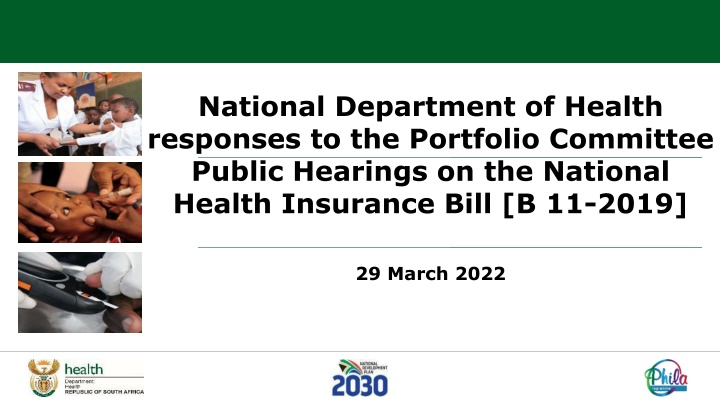


![Stakeholders' Responses to National Health Insurance Bill [B.11B-2019]: Overview](/thumb/69945/stakeholders-responses-to-national-health-insurance-bill-b-11b-2019-overview.jpg)




